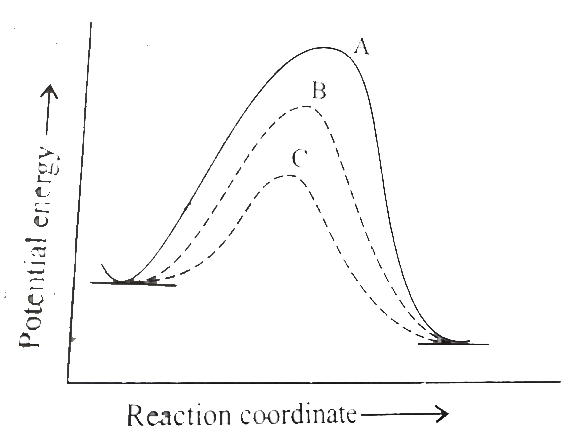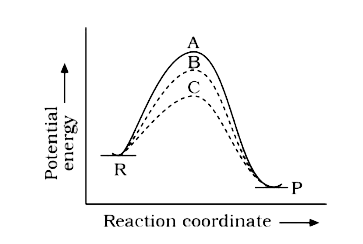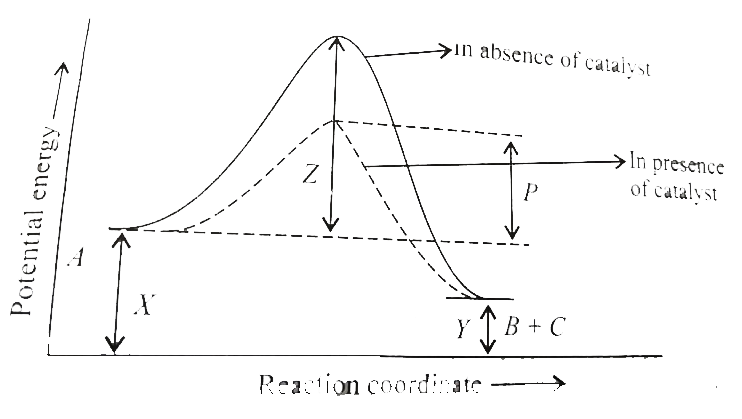Substances which alter the velocity of a reaction by mere presence, without undergoing any change in mass and compossition are termed catalyst and the phenomenon is known as catalysis
In homogenous catalytic reactions, there are three alternative paths A, B, and C (shown in figure). Which one of the following indicates the relative ease with which the reaction can take place?

A.B.C
C>B>A
B.C.A
A=B=C
The correct Answer is:B
Activation energy in the different path lies in the following sequence: C<B<A
Lesser is the activation energy, greater is the ease with which the reaction can take place.
∴C>B>A (Decreasing ease with which the reaction can take place.)
Topper's Solved these Questions
- SURFACE CHEMISTRYBOOK - CENGAGE CHEMISTRY ENGLISHCHAPTER - SURFACE CHEMISTRYEXERCISE - Exercises Multiple Correct
25 Videos
- SURFACE CHEMISTRYBOOK - CENGAGE CHEMISTRY ENGLISHCHAPTER - SURFACE CHEMISTRYEXERCISE - Exercises Single Correct
52 Videos
- SURFACE CHEMISTRYBOOK - CENGAGE CHEMISTRY ENGLISHCHAPTER - SURFACE CHEMISTRYEXERCISE - Exercises Subjective
10 Videos
- SOLUTIONSBOOK - CENGAGE CHEMISTRY ENGLISHCHAPTER - SOLUTIONSEXERCISE - Ex 2.3 (Objective)
9 Videos
- SYNTHETIC AND NATURAL POLYMERSBOOK - CENGAGE CHEMISTRY ENGLISHCHAPTER - SYNTHETIC AND NATURAL POLYMERSEXERCISE - Exercises Assertion Reasoning
10 Videos
Similar Questions
Substances which alter the velocity of a reaction by mere presence, without undergoing any change in mass and compossition are termed catalyst and the phenomenon is known as catalysis
Which is incorrect for a catalyst?
View SolutionA homogenous catalytic reaction takes place through the three alternative plots A, B, and C shown in the given figure. Which one of the following indicates the relative ease with which the reaction cant take place?

View Solution
Knowledge Check
Which of the following statement is correct? A)The rate of a reaction decreases with passage of time as the concentration of reactants decreases. B)The rate of a reaction is same at any time during the reaction C)The rate of a reaction is independent of temperature change D)The rate of a reaction decreases with increase in concentration of reactant(s)
AThe rate of a reaction decreases with passage of time as the concentration of reactants decreases.BThe rate of a reaction is same at any time during the reactionCThe rate of a reaction is independent of temperature changeDThe rate of a reaction decreases with increase in concentration of reactant(s)
Substances which alter the velocity of a reaction by mere presence, without undergoing any change in mass and compossition are termed catalyst and the phenomenon is known as catalysis
According to the adsorption theroy of catalysis, the rate of reaction increases because
View SolutionIf a homogeneous catalytic reaction follows three alternative paths A, B and C, then which of the following indicates the relative ease with which the reaction moves?

View SolutionIf a homogeneous catalytic reaction follows three alternative paths A, B and C, then which of the following indicates the relative ease with which the reaction moves?

View SolutionSubstances which alter the velocity of a reaction by mere presence, without undergoing any change in mass and compossition are termed catalyst and the phenomenon is known as catalysis
For the reaction (A→B+C) , the energy profile diagram is given in the figure below.

The decrease in the energy of activation in the presence of catalyst is
View SolutionGiven a gas phase reaction 2A(g)+B(g)⇔C(g)+D(g). Which one of the following changes will affect the value of Kc?
View SolutionFree enegry , G=H−TS, is state function that indicates whther a reaction is spontaneous or non-spontaneous. If you think of TS as the part of the system's enegry that is disordered already, then (H−TS) is the part of the system's energy that is still ordered and therefore free to cause spontaneous change by becoming disordered.
Also, ΔG=ΔH−TΔS From the second law of thermodynamics, a reaction is spontaneous if ΔtotalS is positive, non-spontaneous if ΔtotalS is negative, and at equilibrium if Δ'→talS is zero.
Since, −TΔS=ΔG and since ΔG and ΔS have opposite sings, we can restate the thermodynamic criterion for the spontaneity of a reaction carried out a constant temperature and pressure.
IF ΔG<0, the reaction is spontaneous.
If ΔG>0, the reaction is non-spontaneous.
If ΔG=0, the reaction is at equilibrium.
Read the above paragraph carefully and answer the following questions based on the above comprehension.
Which of the following is true for the reaction?
H2O(l)⇔H2O(g)at100∘C and 1 atmosphere
View SolutionRedox is a reaction in which both oxidation and reduction will take place simultaneously . It is obvious that if one substance gives electron there must be another substance to accept these electrons . In some reactions, same substance is reduced as well as oxidised, these reactions are termed as disproportionation reactions.
For calculating equivalent mass in redox reaction change in oxidtaion number is realted to n-factor which is reciprocal of molar ratio.
Which of the following is an example of redox reaction ?
View Solution
